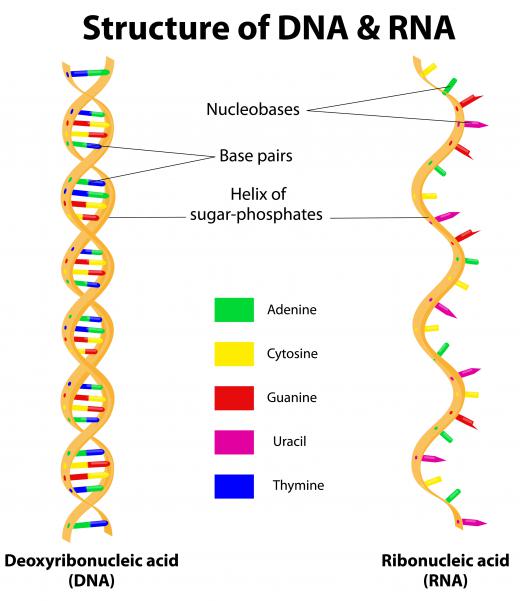What Is RNA Extraction?
Ribonucleic acid (RNA) extraction is a laboratory process commonly used in molecular biological research. By isolating strands of RNA, researchers can study the genetic components of a variety of organisms, from bacteria to humans. Although deoxyribonucleic acid (DNA) is the most common nucleic acid associated with genetic research, RNA is the connection between DNA and the cell proteins responsible for a variety of structural roles. Extraction of RNA allows scientists to study the pathway from DNA information to protein production and cell function.
Nucleic acids, in the form of DNA and RNA, hold the genetic information necessary for cells to function and replicate. Ribonucleic acid, or RNA, is the link between DNA and cell proteins. Specific types of RNA copy specific sections of DNA to assist with the formation of such proteins. Following the path between DNA and cell proteins helps researchers understand gene regulation and protein synthesis within individual cells. Processes that facilitate RNA extraction and ensure sample stability provide researchers with a means to follow the path between DNA and RNA.

During RNA extraction, biological samples are reduced and purified to such an extent that RNA is isolated for later examination. Molecular components, such as proteins, RNA, and DNA, partition or isolate at different times, allowing for the extraction of specific types of RNA. Different tissue and cell types require different methods of RNA extraction. While a variety of methods exist to perform RNA extraction, the most common uses centrifugation to mix biological samples with various chemical compounds, known collectively as denaturants.

One common method of RNA extraction is phenol-chloroform extraction, also known as PC or PCIA. Using this method, tissue samples are mixed with equal parts phenol and chloroform. Known as a biphasic mixture, the solution is centrifuged in a denaturing solution. Two phases result, with the first being the aqueous phase and the second being the organic phase. It is during the aqueous phase that RNA extraction occurs, with the help of ethanol precipitation.
Other methods for extracting RNA vary, depending on sample size, tissue type, and whether total or partial RNA is required. For yeast, plant, or animal samples, complete RNA, or total eukaryotic RNA, samples are needed. Bacterias, on the other hand, require total prokaryotic RNA. Each type of RNA necessitates a different method of sample preparation, extraction, and storage.
Complications with RNA extraction are common and generally relate to the degradation of RNA after extraction. Ribonuclease enzymes commonly present in tissue samples quickly degrades RNA. If not used quickly, RNA degradation can render a sample useless. In response, many methods of RNA extraction include steps for the preparation of samples for storage, both before and after extraction, to reduce or slow the breakdown of RNA.
AS FEATURED ON:
AS FEATURED ON:












Discuss this Article
Post your comments